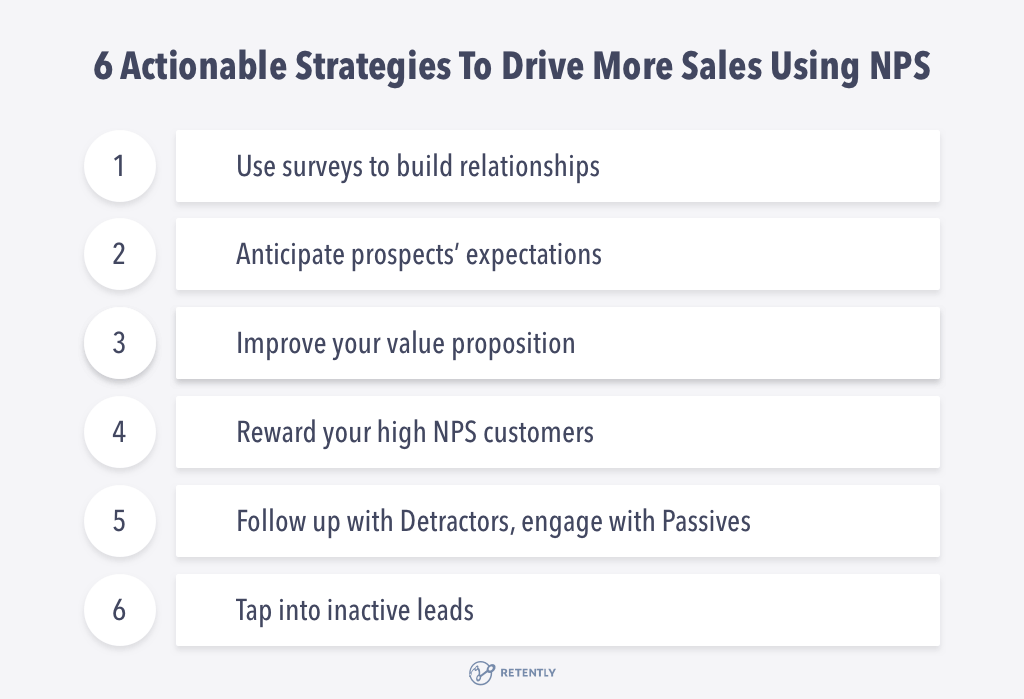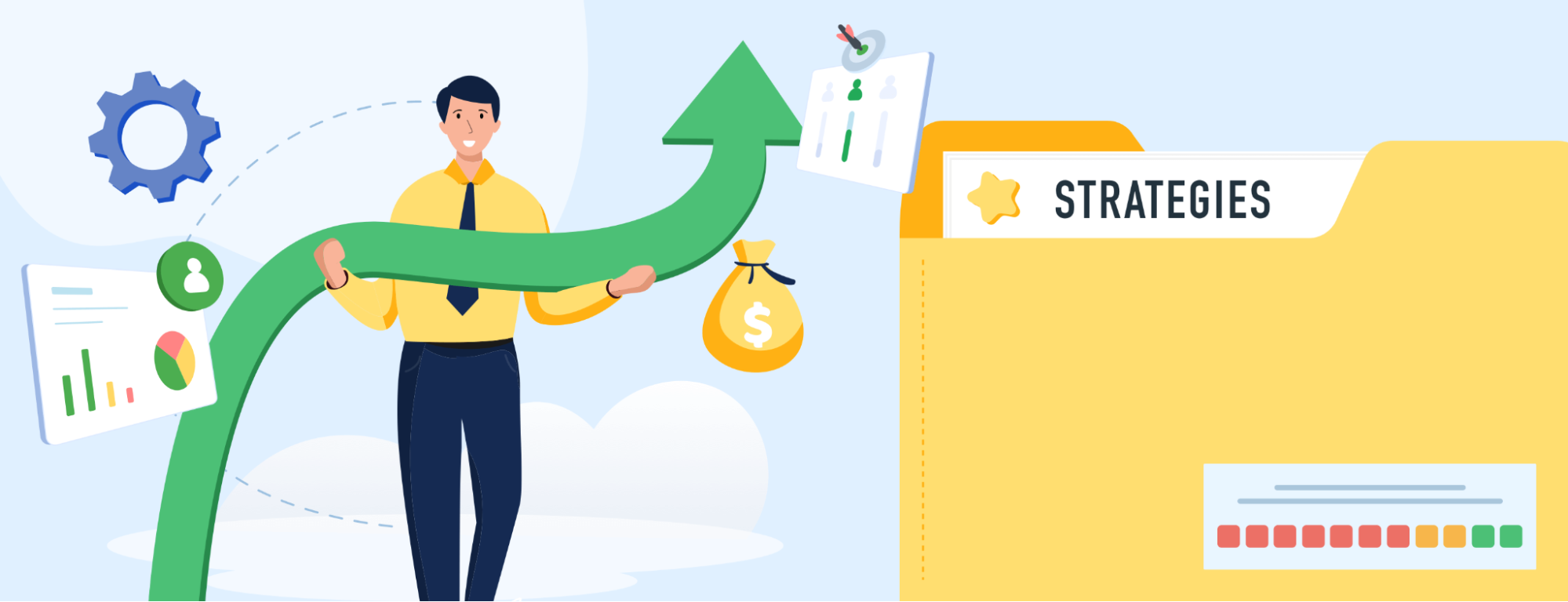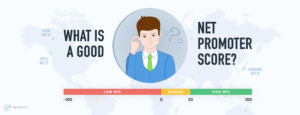While NPS® can be an excellent loyalty and customer satisfaction metric, it can also be much more than that. When used properly, Net Promoter Score® can play a significant role in your prospecting and sales process, essentially doubling your growth efforts by focusing on both customer retention and prospect conversion.
But how do you use NPS to drive more sales and revenue? Well, there’s no denying it can be a bit tricky – surveys and sales aren’t directly related.
Still, that doesn’t mean you can’t use NPS surveys to increase business growth. You won’t even need to scour the web to find out how to do that because – in this article – we’ll quickly show you how to score more sales using NPS.

Key Takeaways
- Customer feedback isn’t just data – it’s a sales strategy. NPS helps you identify where to invest efforts to improve retention and revenue.
- Promoters are willing to spread the word, simply give them the right incentives to turn them into your best marketers.
- Passives need a nudge. More engagement and improved experiences can turn them into committed customers.
- Detractors are a second chance, not a lost cause. A well-handled complaint can turn an unhappy customer into a loyal advocate.
- Personalization boosts conversions. Using NPS data to tailor offers, follow-ups, and customer interactions leads to higher engagement and repeat purchases.
- Happy customers spend more. A strong NPS strategy doesn’t just improve satisfaction – it directly impacts your bottom line.
Rethinking NPS: It’s Not Just a Score, It’s a Sales Strategy
Many businesses collect NPS data, but few truly understand its power. It’s often treated as simply something to track, report, and benchmark. However, NPS is one of the strongest predictors of revenue growth.
When customers give you high NPS scores, they aren’t just saying they like your brand, they’re showing buying behavior that leads to long-term profitability. Likewise, low NPS scores signal missed revenue opportunities, lost referrals, and impending churn.
To fully leverage NPS for sales growth, you need to go beyond measuring and start monetizing. It’s not about the number but what you do with it.
- What if you could turn your happiest customers into an unstoppable word-of-mouth engine?
- What if your indifferent customers became loyal advocates instead of leaving for a competitor?
- What if you could stop customer churn before it even starts?
A strong NPS strategy connects these dots and turns insights into action.
Let’s explore exactly how to transform NPS insights into more sales, better customer relationships, and long-term business growth.
1. Use Surveys to Build Relationships
Adobe estimates that existing customers account for at least 26% of revenue – and that finding new customers costs 7x more than keeping existing clients on board. Despite this, many companies spend far more time and money on acquiring new customers than focus on retaining existing ones. Data shows that the latter is a far more effective strategy for producing a steady, predictable increase in revenue. How much of an increase? Around 67%, according to this research.
And repeat purchases from existing clients are normally based on high satisfaction with your products and services. We say “normally” because there’s an extra factor you need to focus on – customer experience.
How does NPS come into play here? Well, all the feedback you gather by means of surveys tells you precisely what your customers want. What’s more, that data can also help your customer service reps build more personalized messages when they interact with your clients, effectively showing them your brand views them as people, not just a source of income. Overall, that can help you drive growth by improving customer retention. It sets your business apart from the competition before the prospect even thinks about purchasing.
2. Anticipate Prospects’ Expectations
One smart way to make sure you’ll be able to close more deals is to customize your survey so that prospects respond with their expectations for your product rather than with general feedback. Instead of surveying your prospects along with existing customers, run a separate campaign for them. Adjust the survey template to reflect your new audience, and wait for the ratings and responses to flow in.
This way, you’ll find out what exactly a potential customer might expect from your product. With that data, you can focus on specific improvement areas and adjust your offering to the point where any barrier in the customers’ minds (of course, if they match your ideal customer profile) regarding whether or not they made the right choice with your business is destroyed.
What’s more, using customer feedback to improve your product might potentially attract the interest of your former customers. That’s not a guarantee, of course, but there’s a chance to regain the interest of previous Detractors or non-converted prospects who left your brand because they felt like you didn’t listen to their feedback.
Your customers want to deal with reps who are knowledgeable about their business needs – so your sales team needs to spend time and effort getting to know them.
Learning more about your prospects’ expectations makes it far easier for you to convert them into lucrative deals that produce long-term, recurring revenue.
3. Improve Your Value Proposition
A great value proposition can make the difference between closing or losing a deal. Unfortunately, one of the biggest mistakes businesses make is thinking that their value proposition is flawless.
One of the most common reasons deals fail is because the ones responsible for selling the product don’t understand the customer’s needs. By analyzing the feedback from existing customers, you can easily identify the features and benefits they view as most valuable. Surveys can help you refine your offering by focusing on the collected data and aligning it with sales objectives.
Instead of relying on assumptions, you can craft your value proposition around data-driven observations and user feedback to improve your odds of convincing would-be customers that they’re making the right choice.
4. Acknowledge and Reward Promoters
A strong engagement with your business can have a significant impact on boosting sales. You might wonder about the link between the two. The truth is that high NPS customers present a perfect opportunity for upselling and cross-selling. Promoters are passionate about your brand and, hence, more likely to make repeat purchases. By digging into NPS data to analyze their preferences and tailor your approach, you can introduce them to complementary products that enhance their experience and increase sales.
To extend the reach of your brand even further, consider implementing a referral program that encourages Promoters to share their positive experiences with others. Equipping them with the necessary tools to easily spread the word, such as social media sharing options, referral bonuses, or rewarding those who leave product reviews, can serve as a compelling incentive for brand advocacy.
Maintaining their enthusiasm requires ongoing efforts, such as creating targeted marketing campaigns. Exclusive deals and personalized loyalty programs can be effective ways to show appreciation for their support and reinforce your connection. For example, consider inviting your most loyal customers to exclusive events or giving them early access to new products. Small, unexpected gestures – such as birthday discounts or personalized thank-yous – can further strengthen loyalty.
Another way to capitalize on Promoters is through user-generated content. People trust real customer experiences far more than traditional marketing messages, so why not let your happy customers do the selling for you? Encouraging them to share testimonials, reviews, or social media posts showcasing your product can boost credibility and drive conversions.
Regularly assessing and monitoring Promoter churn is essential to maintain a high NPS score and identify potential issues before they become liabilities. By proactively addressing these concerns – whether it’s by improving customer service or refining product offerings – you can set the stage for long-term success.
5. Follow Up With Detractors, Engage With Passives
You could say that Detractors are lost customers, but a better way to think about them is as opportunities to right a wrong and capitalize on that. You see, not every single Detractor is someone who dislikes your product and brand at all – some of them might actually like what you offer but be very disappointed or unsatisfied with certain aspects of your business or a particular customer experience.
If you address and fix those issues, on top of also acknowledging your errors, there is a chance you might leave a strong impression on those people and turn them into customers again.
A tailored customer recovery program does exactly that by turning disappointment into a second chance for loyalty. Offering apology discounts, service credits, or free upgrades can be an effective way to regain trust. At the same time, preventing future frustrations requires a proactive approach. One of the best ways to do this is by analyzing NPS feedback trends to pinpoint recurring pain points – whether it’s slow response times, unclear pricing, or poor onboarding experiences. Once you spot these patterns, take meaningful action to address frequent complaints before they become dealbreakers.
As for Passives, it’s important to use surveys to ask them what improvements they’d like to see with your product, or what issues are preventing them from becoming fans of your brand. Passives are not exactly loyal customers, meaning they are open to other options. If you neglect them, they can easily contribute to your customer churn stats.
However, if you assign them a customer success rep and leverage customer feedback to craft personalized solutions that cater to their unique needs, you’re more likely to nurture and convert them into Promoters. If you achieve that, you’ll essentially increase your revenue in the long run since you’re boosting your retention rate.
Moreover, you can use NPS data to inform your communication strategy and draft messages that resonate with each customer segment. By constantly refining your approach, you’ll rest assured marketing and sales efforts remain impactful.
6. Tap Into Inactive Leads
From time to time, even the strongest opportunities go quiet. If you’ve accumulated a large number of leads going dark, sending an NPS survey is a great way to reconnect and kick-start the sales process once again.
Using NPS to reignite dead opportunities is simple. Instead of sending a survey to your existing customers, create a custom audience to target inactive leads (such as people who have shown an interest in your services/products at the beginning but haven’t responded or taken any action since then).
Don’t use the surveys to ask them how likely they are to recommend your brand to others. Instead, use them to ask what improvements they’d like to see before they’d be willing to start doing business with you.
The great thing about this tactic is that it gives you feedback on why the deal hasn’t progressed. Using this data, you can refine your sales pitch and better connect with each prospect, increasing the likelihood of conversion.
While not everyone will respond to your surveys, the ones that do send an important message — that they’re still interested in talking to you, even if just to provide feedback. Build on this with a compelling pitch and there’s a serious chance of that feedback turning into a lucrative deal.
NPS and Growth – the Bottom Line
Using NPS to boost customer satisfaction and loyalty is definitely going to work in your favor. However, you stand to gain much more by focusing on boosting sales with NPS too. Getting to enjoy brand loyalty and advocacy alongside a decent increase in your client base numbers sounds more than appealing, right? Not to mention you can even use Promoters to improve your brand’s visibility, saving your marketing team tons of time and effort.
Your NPS can be a sales growth engine. The question is: Are you ready to turn feedback into revenue?
In case you’re looking for NPS survey software, we’ve got you covered. Retently offers a fully integrated solution that’s extremely easy to use, works across multiple channels, and lets you set up plenty of time-saving automation scenarios. Test it out in a free trial in order to:
- boost customer lifetime value by keeping customers engaged.
- increase repeat purchases with targeted offers and experiences.
- build stronger relationships by listening, adapting, and delivering real value.



































 Alex Bitca
Alex Bitca 


 Greg Raileanu
Greg Raileanu 
 Christina Sol
Christina Sol 
